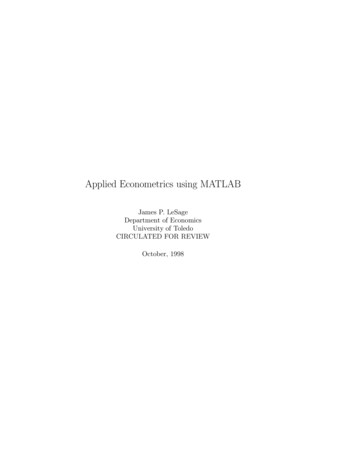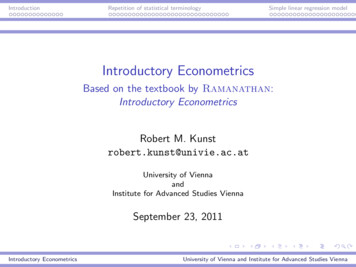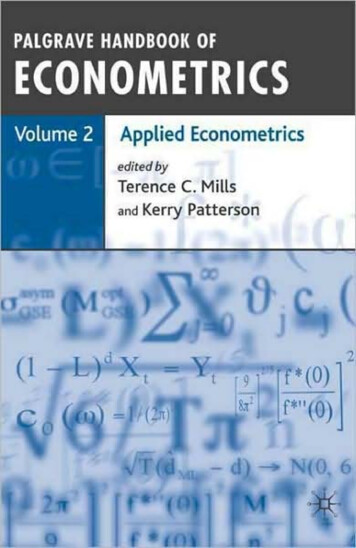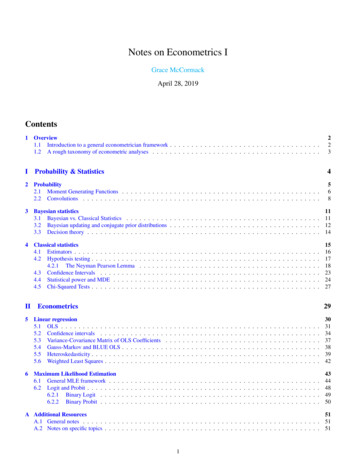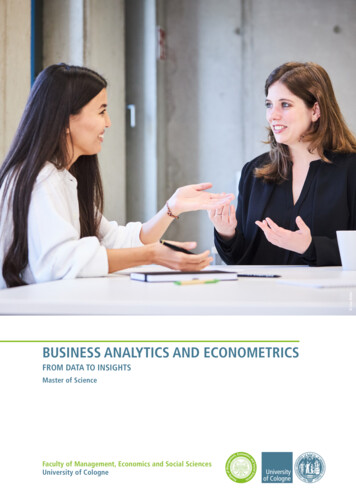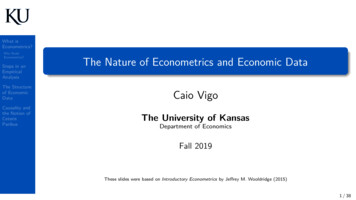
Transcription
What isEconometrics?Why StudyEconometrics?Steps in anEmpiricalAnalysisThe Structureof EconomicDataCausality andthe Notion ofCeterisParibusThe Nature of Econometrics and Economic DataCaio VigoThe University of KansasDepartment of EconomicsFall 2019These slides were based on Introductory Econometrics by Jeffrey M. Wooldridge (2015)1 / 38
TopicsWhat isEconometrics?Why StudyEconometrics?Steps in anEmpiricalAnalysis1What is Econometrics?Why Study Econometrics?2Steps in an Empirical Analysis3The Structure of Economic Data4Causality and the Notion of Ceteris ParibusThe Structureof EconomicDataCausality andthe Notion ofCeterisParibus2 / 38
What is Econometrics?What isEconometrics?Why StudyEconometrics?Steps in anEmpiricalAnalysisThe Structureof EconomicDataCausality andthe Notion ofCeterisParibus Econometrics is the set of tools by which economists, and others in the socialsciences, analyze data. We can use econometrics to: Estimate economic relationships; Test economic theories; Evaluate government and business policy.3 / 38
What is Econometrics?What isEconometrics?Why StudyEconometrics?Steps in anEmpiricalAnalysisThe Structureof EconomicDataCausality andthe Notion ofCeterisParibusEconometrics focuses on problems inherent in analyzing data generated byindividuals, firms, and other entitities acting strategically, and interacting with oneanother. For example: Does higher school spending is related with higher SAT/ACT scores? What are the effects to the US economy if we raise our tariffs? What is the effect of a 20-week training program on worker’s hourly wage? What are the effects on crime rates if we legalize marijuana?4 / 38
What is Econometrics?What isEconometrics?Why StudyEconometrics?Steps in anEmpiricalAnalysisThe Structureof EconomicDataCausality andthe Notion ofCeterisParibus A simple correlation analysis might not be sufficient because causality can bedifficult to infer. In economics, theory and empirical analysis are both important. An empirical analysis uses data to test a theory, estimate an economicrelationship, or determine the effects of a policy or intervention. Econometrics allowsus to analyze data using formal statistical methods.5 / 38
What is Econometrics?What isEconometrics?Why StudyEconometrics?Steps in anEmpiricalAnalysisThe Structureof EconomicDataCausality andthe Notion ofCeterisParibus6 / 38
Is Econometrics Statistics?What isEconometrics?Why StudyEconometrics?Steps in anEmpiricalAnalysisThe Structureof EconomicDataCausality andthe Notion ofCeterisParibus Econometrics is its own discipline (separate from statistics) mainly because thereexists the following difference:Experimental Data 6 Nonexperimental Data7 / 38
Is Econometrics Statistics?What isEconometrics?Why StudyEconometrics?Steps in anEmpiricalAnalysisThe Structureof EconomicDataCausality andthe Notion ofCeterisParibus Experimental data: Data from controlled experiments; Common in the natural sciences (physics, chemistry, .) and in the biomedicalfields; However, harder to find or generate in the social sciences (although some exist).8 / 38
Is Econometrics Statistics?What isEconometrics?Why StudyEconometrics?Steps in anEmpiricalAnalysisThe Structureof EconomicDataCausality andthe Notion ofCeterisParibus Nonexperimental data These are data sets collected in a passive manner, after we observe outcomes onindividuals, firms, schools, and so on. We just “observe” the data without having any control over it,i.e., we simplyact as “observers”of what has happened and then try to learn from what weobserve. Other names for nonexperimental data: observational or retrospective data.9 / 38
Why Study Econometrics?What isEconometrics?Why StudyEconometrics?Steps in anEmpiricalAnalysisThe Structureof EconomicDataCausality andthe Notion ofCeterisParibus Important to be able to apply economic theory to real world data. Theory may be ambiguous as to the effect of some policy change, and in any casetheory rarely tells us how large the effect might be. Forecasting economic variables (inflation, interest rates, housing starts, and so on)is important, too.10 / 38
TopicsWhat isEconometrics?Why StudyEconometrics?Steps in anEmpiricalAnalysis1What is Econometrics?Why Study Econometrics?2Steps in an Empirical Analysis3The Structure of Economic Data4Causality and the Notion of Ceteris ParibusThe Structureof EconomicDataCausality andthe Notion ofCeterisParibus11 / 38
Steps for a Successful Empirical StudyWhat isEconometrics?Why StudyEconometrics?Steps in anEmpiricalAnalysisThe Structureof EconomicDataCausality andthe Notion ofCeterisParibusSteps for a Successful Empirical StudyStep 1: Carefully pose a question.Step 2: Specify an economic or conceptual model.Step 3: Turn the economic model into an econometric model.Step 4: Collect data on the variables and use statistical methods to estimate theparameters, construct confidence intervals for the parameters, and test hypotheses.12 / 38
Step 2. Specify an economic modelWhat isEconometrics?Why StudyEconometrics?Steps in anEmpiricalAnalysisThe Structureof EconomicDataCausality andthe Notion ofCeterisParibusStep 2. Specify an economic model, or at least a conceptual model, to study thephenomenon of interest. Formal economic modeling (such as utility maximizaton) isoften used, but one can get by with careful economic reasoning that is less formal.ExampleTo study the effects of job training on worker productivity, where productivity ismeasured by observed hourly wage, we can start with an equation such aswage f (educ, exper, training)where educ is a measure of schooling, exper is a measure of workforce experience,and training is a measure of time spent in job training (the variable of mostinterest).13 / 38
Step 3: Turn the economic model into an econometric modelWhat isEconometrics?Why StudyEconometrics?Steps in anEmpiricalAnalysisThe Structureof EconomicDataCausality andthe Notion ofCeterisParibusExampleWe can specify an econometric model for the wage/job training example aswage β0 β1 educ β2 exper β3 training u The constants β0 , β1 , β2 , and β3 (“the betas”) are the parameters of the model,and it is these (especially β3 in this example) that we hope to estimate. Ideally we will be able to collect data on wage, educ, exper, and training from alarge group of working people.14 / 38
Step 3: Turn the economic model into an econometric modelWhat isEconometrics?Why StudyEconometrics?Steps in anEmpiricalAnalysisThe Structureof EconomicDataCausality andthe Notion ofCeterisParibus The last term in the equationwage β0 β1 educ β2 exper β3 training uis u. It’s called the error term or disturbance. It plays a very important role in econometrics. It represents all other factors that can affects someone’s wage, including nativeintelligence, motivation, and so on. The error term can also capture measurement problems in one or more of thevariables.15 / 38
Step 3: Turn the economic model into an econometric modelWhat isEconometrics?Why StudyEconometrics?Steps in anEmpiricalAnalysisThe Structureof EconomicDataCausality andthe Notion ofCeterisParibus We will want to use statistical methods, and data, to estimate and test hypothesesabout the parameters. For example, the hypothesis that job training has no effect on wage is β3 0. The hypothesis that one year of experience is worth one year of education isβ1 β2 .16 / 38
Steps for a Successful Empirical StudyWhat isEconometrics?Why StudyEconometrics?Steps in anEmpiricalAnalysisStep 1: Carefully pose a question.The Structureof EconomicDataStep 2: Specify an economic or conceptual model.Causality andthe Notion ofCeterisParibusStep 3: Turn the economic model into an econometric model.Step 4: Collect data on the variables and use statistical methods to estimate theparameters, construct confidence intervals for the parameters, and test hypotheses.17 / 38
TopicsWhat isEconometrics?Why StudyEconometrics?Steps in anEmpiricalAnalysis1What is Econometrics?Why Study Econometrics?2Steps in an Empirical Analysis3The Structure of Economic Data4Causality and the Notion of Ceteris ParibusThe Structureof EconomicDataCausality andthe Notion ofCeterisParibus18 / 38
The Structure of Economic DataWhat isEconometrics?Why StudyEconometrics?Steps in anEmpiricalAnalysisThe Structureof EconomicDataCausality andthe Notion ofCeterisParibus Economic data sets come in a variety of types.Types of Economic Data Cross-Sectional Data Time Series Data Pooled Cross Sections Panel or Longitudinal Data19 / 38
Cross-Sectional DataWhat isEconometrics?Why StudyEconometrics?Steps in anEmpiricalAnalysisThe Structureof EconomicDataCausality andthe Notion ofCeterisParibus Data are collected on individuals, families, firms, schools, or some other units at agiven point in time. Time is not important. It does not play a crucial role. We will assume that a cross-sectional data set represents a random sample.What is random sample again? Example20 / 38
Cross-Sectional DataWhat isEconometrics?Why StudyEconometrics?Steps in anEmpiricalAnalysisThe Structureof EconomicDataCausality andthe Notion ofCeterisParibusThe Importance of Random Sampling Random sampling (with replacement) generates observations that are i.i.d. Intuitively, a random sample is representative of the population of interest,and gives us the best chance of learning about the population.21 / 38
Cross-Sectional DataWhat isEconometrics?Why StudyEconometrics?Steps in anEmpiricalAnalysisThe Structureof EconomicDataCausality andthe Notion ofCeterisParibus Ordering of the individuals is arbitrary and unimportant. Does not matter whom we label observation 2, or observation 5, or observation136 and so on. What happens if I shuffle the dataset?Nothing would be lost be if we randomly rearrange the order of the individuals.22 / 38
Time Series DataWhat isEconometrics?Why StudyEconometrics?Steps in anEmpiricalAnalysisThe Structureof EconomicDataCausality andthe Notion ofCeterisParibus Consists of observations on variables observed over a stretch of time. Examplesinclude interest rates, unemployment rates, and crime rates. A key feature of time series data is that the order is important. We need to know,for example, that the outcome on unemployment in 2008 precedes that for 2009.Time Series correlated observations23 / 38
Time Series DataWhat isEconometrics?Why StudyEconometrics?Steps in anEmpiricalAnalysisThe Structureof EconomicDataCausality andthe Notion ofCeterisParibus Another important difference with cross-sectional data is that we cannot assumeoutcomes are independent across observation (that is, across time).For example, knowing what gross domestic product is in 2009 tells us a lot about itslikely range in 2010. When we apply econometric methods to time series data, we will have to recognizethat the observations are correlated across time.24 / 38
Time Series DataWhat isEconometrics?Why StudyEconometrics?Steps in anEmpiricalAnalysis Many time series exhibit clear trends. While real GDP sometimes rises andsometimes falls, on average it has grown over time.The Structureof EconomicData The notion of trend is not relevant for cross-sectional data.Causality andthe Notion ofCeterisParibus The frequency with which time series data are recorded can also be important. Are the data observed once a month? Once a quarter? Annually? Daily, such as closing prices for the stock market.?25 / 38
Independently Pooled Cross SectionsWhat isEconometrics?Why StudyEconometrics?Steps in anEmpiricalAnalysisThe Structureof EconomicDataCausality andthe Notion ofCeterisParibus A data set consisting of independently pooled cross sections means that we havecollect cross-sectional data at different points in time and pool them together.ExampleWe may randomly sample from the working U.S. population in 1990, 2000, and 2010.Our goal may be to see how the importance of attending college on salaries haschanged over time. If we obtain a random sample in each year it would be very small compared tothe entire population. It would be very rare that the same person would appear twice; if someoneappears twice nothing is harmed by ignoring that fact.26 / 38
Independently Pooled Cross SectionsWhat isEconometrics?Why StudyEconometrics?Steps in anEmpiricalAnalysisThe Structureof EconomicDataCausality andthe Notion ofCeterisParibus Pooled cross sections are very useful for policy analysis - to study an intervention. The idea is to collect data from the years before and after a key policy change.ExampleHow does a new incinerator affect the sales price of homes? Because the observations are independent (both within and across time periods),pooled cross sections can be analyzed much like a single cross section.27 / 38
Independently Pooled Cross SectionsWhat isEconometrics?Why StudyEconometrics?Steps in anEmpiricalAnalysisThe Structureof EconomicDataCausality andthe Notion ofCeterisParibusSource: Wooldridge, Jeffrey M. (2015). Introductory Econometrics: A Modern Approach.28 / 38
Panel DataWhat isEconometrics?Why StudyEconometrics?Steps in anEmpiricalAnalysis Panel data set has a structure similar to a pooled cross section.The Structureof EconomicData Main difference: the same units (people, houses, schools, and so on) are followedover time.Causality andthe Notion ofCeterisParibus Following the same units over time has advantages when trying to infer causality. Panel data analysis is a more advanced topic.29 / 38
Panel DataWhat isEconometrics?Why StudyEconometrics?Steps in anEmpiricalAnalysisThe Structureof EconomicDataCausality andthe Notion ofCeterisParibusSource: Wooldridge, Jeffrey M. (2015). Introductory Econometrics: A Modern Approach.30 / 38
TopicsWhat isEconometrics?Why StudyEconometrics?Steps in anEmpiricalAnalysis1What is Econometrics?Why Study Econometrics?2Steps in an Empirical Analysis3The Structure of Economic Data4Causality and the Notion of Ceteris ParibusThe Structureof EconomicDataCausality andthe Notion ofCeterisParibus31 / 38
CausalityWhat isEconometrics?Why StudyEconometrics?Steps in anEmpiricalAnalysisThe Structureof EconomicDataCausality andthe Notion ofCeterisParibus The concept of causality is key in econometrics. Does bigger high schools causes students to have a higher GPA? Does bigger citiescauses a higher number of crimes?Correlation ; CausalityFinding correlations in data might be suggestive but is RARELY conclusive.32 / 38
CausalityWhat isEconometrics?Why StudyEconometrics?Steps in anEmpiricalAnalysisThe Structureof EconomicDataCausality andthe Notion ofCeterisParibus Crucial to establishing causality is the notion of ceteris paribus: “all (relevant)factors equal.” If we succeed, via statistical methods, in “holding fixed” all other relevant factors,then SOMETIMES we establish that changes in one variable (say, education) infact “cause” changes in another variable (wage).33 / 38
CausalityWhat isEconometrics?Why StudyEconometrics?Steps in anEmpiricalAnalysisThe Structureof EconomicDataCausality andthe Notion ofCeterisParibus34 / 38
CausalityWhat isEconometrics?Why StudyEconometrics?Steps in anEmpiricalAnalysisThe Structureof EconomicDataCausality andthe Notion ofCeterisParibusExample: What is the value of another year of education on one’s earnings? We can imagine the type of experiment we would have to run to obtainexperimental data. At birth, each child is randomly given a highest grade that he/she must complete –no more, no less. Then, we eventually record, hourly or monthly or annual earnings.35 / 38
CausalityWhat isEconometrics?Why StudyEconometrics?Steps in anEmpiricalAnalysisThe Structureof EconomicDataCausality andthe Notion ofCeterisParibus The experiment is not feasible, and would be morally repugnant, anyway. For problems such as measuring the value of education, we must usually rely onobservational data. We can, for very large random samples of people, collectinformation on education and earnings.36 / 38
CausalityWhat isEconometrics?Why StudyEconometrics?Steps in anEmpiricalAnalysisThe Structureof EconomicDataCausality andthe Notion ofCeterisParibus The problem for inferring causality from, say, a simple correlation analysis is thatindividuals and their parents largely determine the amount of schooling. Probably on average people who are smarter or more capable choose to becomebetter educated. But more capable people would earn more, on average, than lesscapable individuals. Seeing a positive correlation between earnings and schooling need not imply that itis due to schooling. Other confounding factors (such as intelligence and past experience) couldexplain most of the difference in earnings.37 / 38
CausalityWhat isEconometrics?Why StudyEconometrics?Steps in anEmpiricalAnalysisThe Structureof EconomicDataCausality andthe Notion ofCeterisParibus The problem of individuals influencing their education levels is an example ofself-selection.Example Suppose we want to study the effects of attending college lectures on performancein a course. If the better students, on average, also attend lectures more frequently, a simplecorrelation analysis can be misleading.The individuals (i.e.,students) self-select into the variable (i.e., how muchthey attend lecture). Self-selection is often a serious concern in the social sciences.38 / 38
What is Econometrics? A simple correlation analysis might not be sufficient because causality can be difficult to infer. In economics, theory and empirical analysis are both important. An empirical analysis uses data to test a theory, estimate an economic relationship, or determine the effects of a policy or intervention. Econometrics .


